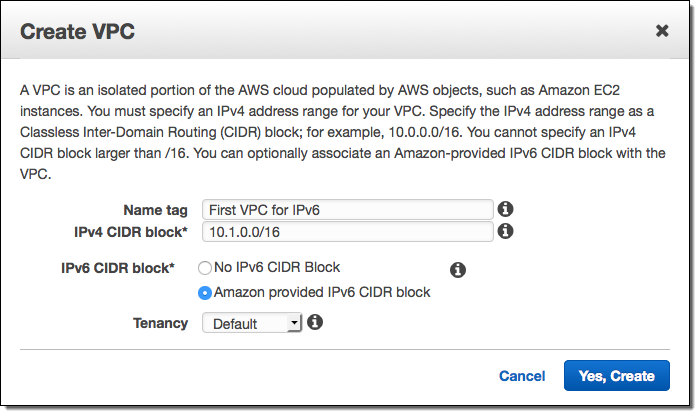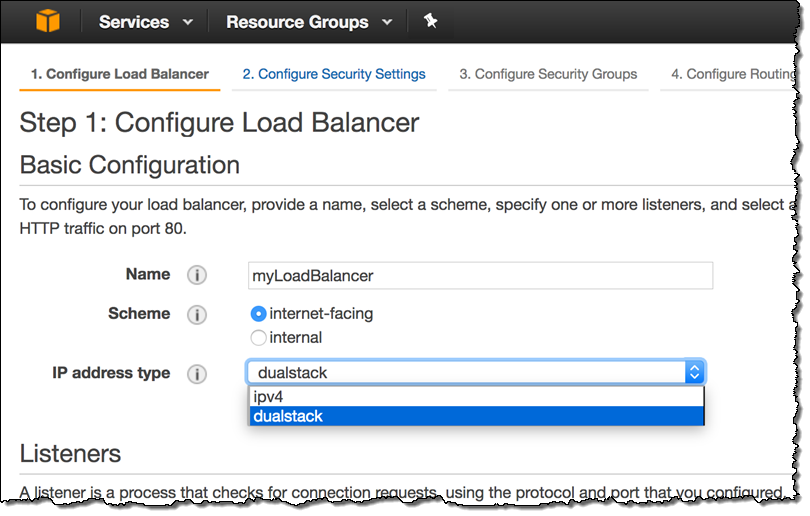AWS News Blog
AWS IPv6 Update – Global Support Spanning 15 Regions & Multiple AWS Services
|
|
We’ve been working to add IPv6 support to many different parts of AWS over the last couple of years, starting with Elastic Load Balancing, AWS IoT Core, AWS Direct Connect, Amazon Route 53, Amazon CloudFront, AWS Web Application Firewall, and S3 Transfer Acceleration, all building up to last month’s announcement of IPv6 support for EC2 instances in Virtual Private Clouds (initially available for use in the US East (Ohio) Region).
Today I am happy to share the news that IPv6 support for EC2 instances in VPCs is now available in a total of fifteen regions, along with Application Load Balancer support for IPv6 in nine of those regions.
You can now build and deploy applications that can use IPv6 addresses to communicate with servers, object storage, load balancers, and content distribution services. In accord with the latest guidelines for IPv6 support from Apple and other vendors, your mobile applications can now make use of IPv6 addresses when they communicate with AWS.
IPv6 Now in 15 Regions
IPv6 support for EC2 instances in new and existing VPCs is now available in the US East (N. Virginia), US East (Ohio), US West (N. California), US West (Oregon), South America (São Paulo), Canada (Central), Europe (Ireland), Europe (Frankfurt), Europe (London), Asia Pacific (Tokyo), Asia Pacific (Singapore), Asia Pacific (Seoul), Asia Pacific (Sydney), Asia Pacific (Mumbai), and AWS GovCloud (US) Regions and you can start using it today!
You can enable IPv6 from the AWS Management Console when you create a new VPC:

Application Load Balancer
Application Load Balancers in the US East (N. Virginia), US West (N. California), US West (Oregon), South America (São Paulo), Europe (Ireland), Asia Pacific (Tokyo), Asia Pacific (Singapore), Asia Pacific (Sydney), and AWS GovCloud (US) Regions now support IPv6 in dual-stack mode, making them accessible via IPv4 or IPv6 (we expect to add support for the remaining regions within a few weeks).
Simply enable the dualstack option when you configure the ALB and then make sure that your security groups allow or deny IPv6 traffic in accord with your requirements. Here’s how you select the dualstack option:

You can also enable this option by running the set-ip-address-type command or by making a call to the SetIpAddressType function. To learn more about this new feature, read the Load Balancer Address Type documentation.
IPv6 Recap
Here are the IPv6 launches that we made in the run-up to the launch of IPv6 support for EC2 instances in VPCs:
CloudFront, WAF, and S3 Transfer Acceleration – This launch let you enable IPv6 support for individual CloudFront distributions. Newly created distributions supported IPv6 by default and existing distributions could be upgraded with a couple of clicks (if you using Route 53 alias records, you also need to add an AAAA record to the domain). With IPv6 support enabled, the new addresses will show up in the CloudFront Access Logs. The launch also let you use AWS Web Application Firewall to inspect requests that arrive via IPv4 or IPv6 addresses and to use a new, dual-stack endpoint for S3 Transfer Acceleration.
Route 53 – This launch added support for DNS queries over IPv6 (support for the requisite AAAA records was already in place). A subsequent launch added support for Health Checks of IPv6 Endpoints, allowing you to monitor the health of the endpoints and to arrange for DNS failover.
IoT – This product launch included IPv6 support for message exchange between devices and AWS IoT Core.
S3 – This launch added support for access to S3 buckets via dual-stack endpoints.
Elastic Load Balancing – This launch added publicly routable IPv6 addresses for Elastic Load Balancers.
Direct Connect – Supports single and dualstack configurations on public and private VIFs (virtual interfaces).
— Jeff;
